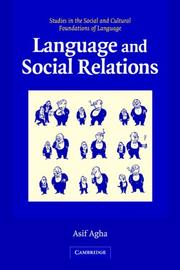| Listing 1 - 3 of 3 |
Sort by
|
Book
Year: 1988 Publisher: Paris : Hatier ; Crédif,
Abstract | Keywords | Export | Availability | Bookmark
 Loading...
Loading...Choose an application
- Reference Manager
- EndNote
- RefWorks (Direct export to RefWorks)

ISBN: 0521576857 9780521576857 9780521571760 0521571766 9780511618284 9780511257230 0511257236 0511256736 9780511256738 9780511255632 0511255632 051161828X 9786610709922 6610709920 1107157293 1280709928 0511319495 0511256205 Year: 2007 Volume: no. 24 Publisher: Cambridge Cambridge University Press
Abstract | Keywords | Export | Availability | Bookmark
 Loading...
Loading...Choose an application
- Reference Manager
- EndNote
- RefWorks (Direct export to RefWorks)
Language is closely linked to our social relationships and is the medium through which we participate in a variety of social activities. This fascinating study explores the important role of language in various aspects of our social life, such as identity, gender relations, class, kinship, status, and hierarchies. Drawing on data from over thirty different languages and societies, it shows how language is more than simply a form of social action; it is also an effective tool with which we formulate models of social life and conduct. These models - or particular forms of social behaviour - are linked to the classification of 'types' of action or actor, and are passed 'reflexively' from person to person, and from generation to generation. Providing a unified way of accounting for a variety of social phenomena, this book will be welcomed by all those interested in the interaction between language, culture, and society.
Sociolinguistics --- Sociolinguistics. --- Interpersonal communication. --- Sociolinguistique --- Communication interpersonnelle --- Interpersoonlijke communicatie ( culturele antropologie ) --- Interpersoonlijke communicatie --- Sociolinguïstiek --- Taal en cultuur --- Taal en sociale relaties --- Interpersoonlijke communicatie ( culturele antropologie ). --- Interpersoonlijke communicatie. --- Sociolinguïstiek. --- Taal en cultuur. --- Taal en sociale relaties. --- Interpersonal communication --- Language and languages --- Language and society --- Society and language --- Sociology of language --- Language and culture --- Linguistics --- Sociology --- Integrational linguistics (Oxford school) --- Communication --- Interpersonal relations --- Social aspects --- Sociological aspects --- Arts and Humanities --- Language & Linguistics --- Langage --- Aspect social
Multi
ISBN: 9780521864176 0521864178 9780521682824 0521682827 9780511626692 9780511719578 0511719574 9780511516948 0511516940 051162669X 1107196884 9781107196889 1282539450 9781282539457 9786612539459 6612539453 0511719124 9780511719127 0511515669 9780511515668 0511718667 9780511718663 Year: 2009 Publisher: Cambridge Cambridge University Press
Abstract | Keywords | Export | Availability | Bookmark
 Loading...
Loading...Choose an application
- Reference Manager
- EndNote
- RefWorks (Direct export to RefWorks)
Language is a means we use to communicate feelings; we also reflect emotionally on the language we and others use. James Wilce analyses the signals people use to express emotion, looking at the social, cultural and political functions of emotional language around the world. His book demonstrates that speaking, feeling, reflecting, and identifying are interrelated processes and shows how desire or shame are attached to language. Drawing on nearly one hundred ethnographic case studies, it demonstrates the cultural diversity, historical emergence, and political significance of emotional language. Wilce brings together insights from linguistics and anthropology to survey an extremely broad range of genres, cultural concepts, and social functions of emotional expression.
Psycholinguistics --- Ethnology. Cultural anthropology --- Affective and dynamic functions --- Sociolinguistics --- Anthropological linguistics. --- Laments. --- Language and emotions. --- Antropologische linguïstiek --- Emoties --- Interpersoonlijke communicatie ( culturele antropologie ) --- Taal en emoties --- Uitdrukking van emoties en cultuur --- sociale aspecten --- Antropologische linguïstiek. --- Interpersoonlijke communicatie ( culturele antropologie ). --- Taal en emoties. --- Uitdrukking van emoties en cultuur. --- sociale aspecten. --- Anthropological linguistics --- Laments --- Language and emotions --- Emotions and language --- Emotions --- Complancha --- Lamentations --- Elegiac poetry --- Mourning customs --- Anthropo-linguistics --- Ethnolinguistics --- Language and ethnicity --- Linguistic anthropology --- Linguistics and anthropology --- Anthropology --- Language and culture --- Linguistics --- Arts and Humanities --- Language & Linguistics
| Listing 1 - 3 of 3 |
Sort by
|

 Search
Search Feedback
Feedback About UniCat
About UniCat  Help
Help News
News